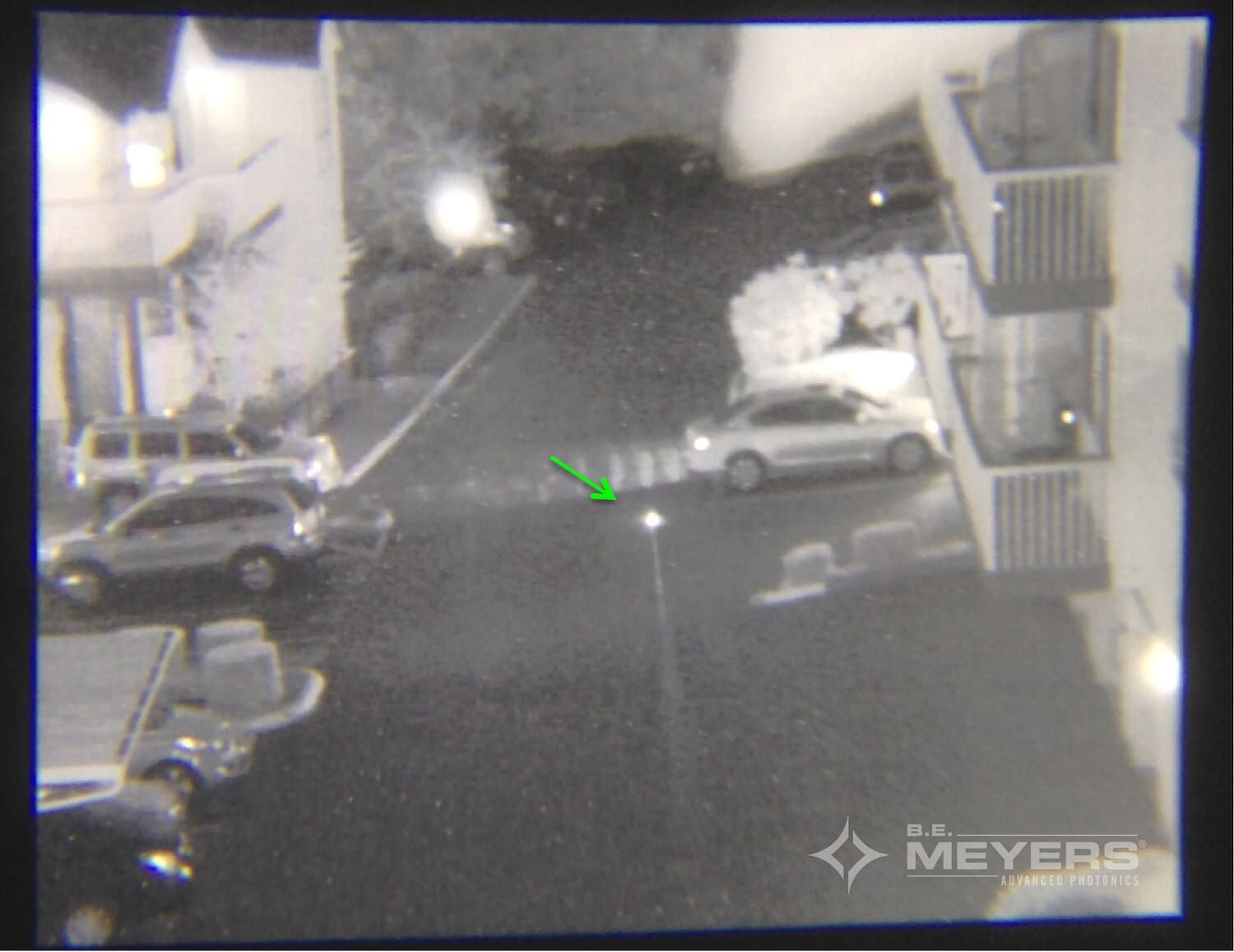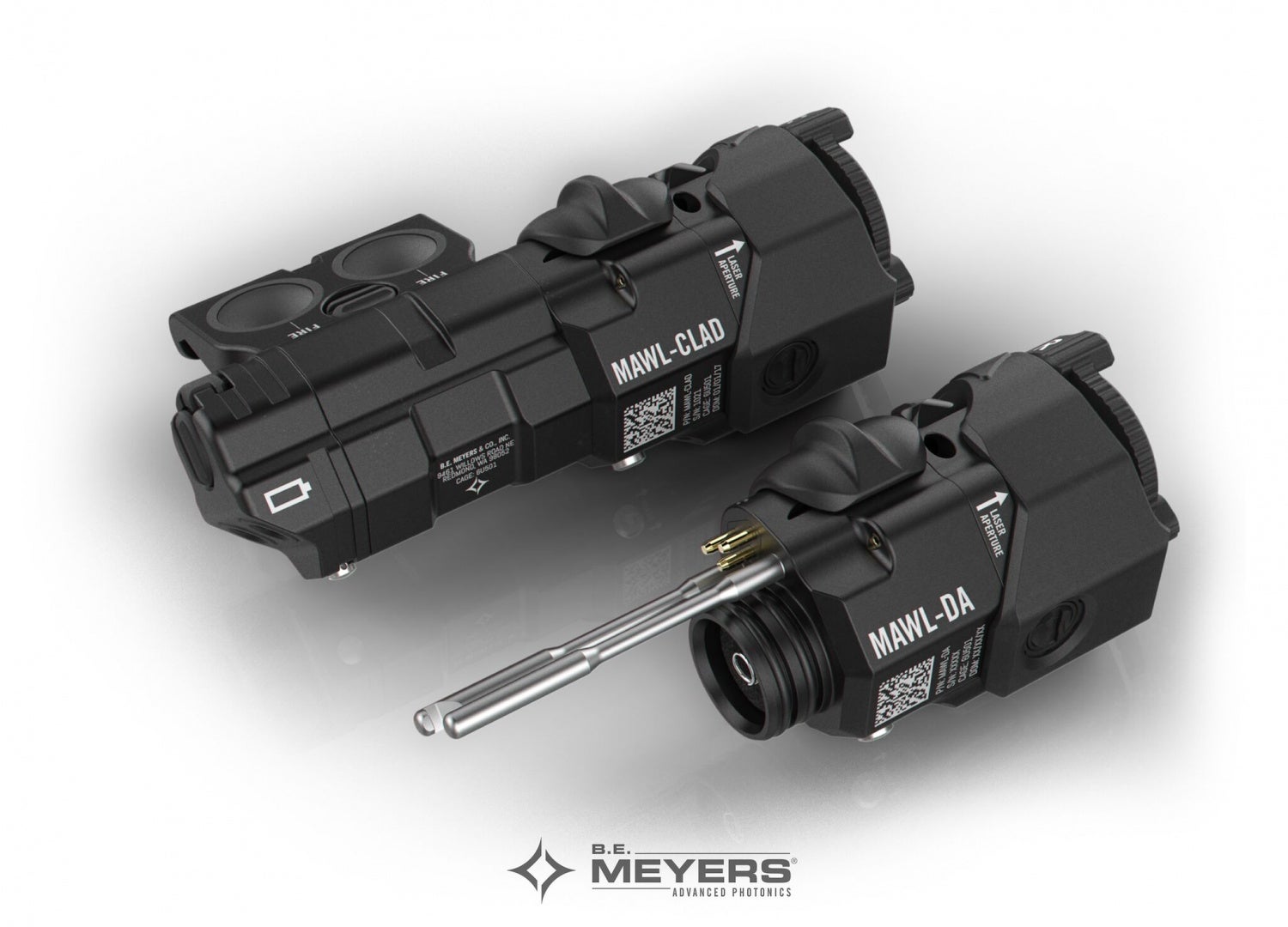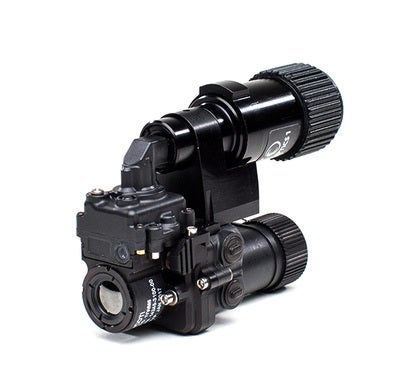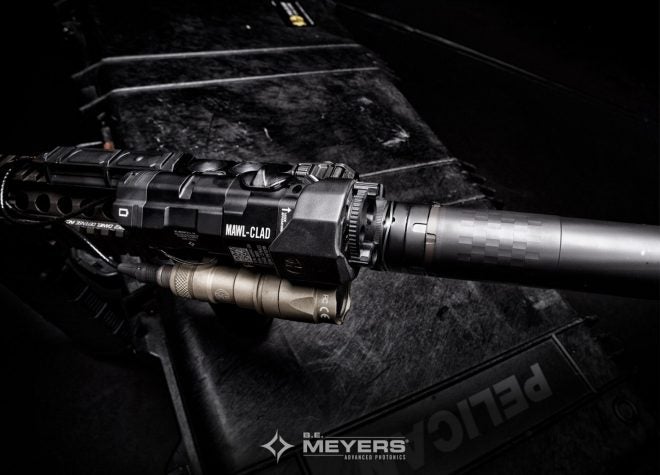Got IR Lasers and Night Vision? Well now there is something even more invisible than that. SWIR is a lower wavelength on the infrared spectrum. NIR (Near Infrared) is what most night vision sees and IR lasers are set to. NIR is 0.75–1.4 µm. SWIR is 1.4–3 µm. What does this mean? You cannot see it with a normal night vision device.
October 9, 2017 (Redmond, WA) –
B.E. Meyers & Co., Inc. is proud to announce the release of a new variant of the MAWL series of weapon aiming lasers and illuminators: the MAWL-CLAD (Covert Laser Aiming Device).
The MAWL-CLAD distinguishes itself from other MAWL variants through the inclusion of a Short-wave Infrared (SWIR) laser pointer. This laser is undetectable by most common Near Infrared (NIR) night vision systems and other visual augmentation sensors, but is compatible with a variety of SWIR systems (i.e. E-COSI) currently in use with Special Operations Forces.
The MAWL-CLAD retains the NIR wavelength diodes present in other MAWL models to provide both marking and illumination for its primary “IR” function mode. This NIR system is visible with most common night vision systems and provides users with an effective aiming, illumination, and signaling solution for almost any low-light/no-light scenario. With the MAWL-CLAD, users can now seamlessly transition between a full suite of NIR aiming and illumination modes and a SWIR laser pointer for aiming or signaling when necessary, making it compatible with all current night vision systems.
The MAWL-CLAD is part of a greater MAWL (Modular Aiming Weapon Laser) system that allows operators to shoot, move and communicate effectively. Its modular head includes a SWIR option (made possible through replacement of the standard green visible laser pointer found on the MAWL-DA and MAWL-C1+) that can be used interchangeably with any existing MAWL platform. This swap can be done while leaving the main housing attached to the weapon rail. Like the visible green laser on other MAWL models, the SWIR pointer on the MAWL-CLAD is coaligned with the NIR pointer, allowing it to be zeroed without a SWIR sensor.
“The MAWL-CLAD allows us to take advantage of the modular design aspects of the MAWL system, and lets the end-user adjust between pre-boresighted, capability specific laser modules, as needed for special mission sets” said Matt Meyers, President of B.E. Meyers & Co. Inc. “With the increased number of SWIR sensors being fielded to Special Operations Forces, the MAWL-CLAD lets the operator choose between SWIR and NIR capability on the move, and also allows them to revert back to the VIS and NIR capability in a matter of seconds by switching to the MAWL-DA Head without detaching the main body of the laser, or losing zero.”
The MAWL-CLAD is the third variant in the MAWL family of weapon laser systems. For more information about the MAWL-DA, MAWL-C1+, and MAWL-CLAD, including product demonstrations and purchasing options, please contact the B.E. Meyers & Co. team at sales@bemeyers.com.
Mark Larue, at Big 3 East, had mentioned that there is a concern that bad guys have been taking digital cameras and removing the hot mirror IR filter to spot IR lights and lasers. Since SWIR is a different and higher spectrum the MAWL CLAD should be invisible to that technology.

BE Meyers has made an SWIR head for their flagship MAWL laser unit. CLAD (Covert Laser Aiming Device)

All you need to do is swap heads and you have an SWIR capable laser device.
So if you cannot see SWIR with normal night vision, what can see SWIR spectrum? E-COSI is a clip on device that injects the SWIR image into night vision devices.
The Optics 1 Enhanced Clip-On SWIR Imager (E-COSI) is a multi-function device with replaceable display heads, allowing the SWIR image to be:
- Injected into NVG, overlaying the SWIR image onto the NVG image
- Seen during the day with an optional see-through day optic (for See-Spot operations)
- Exported to outside devices for external recording/monitor input
Night Vision Devices (NVDs) work well for target pointing and marking/identification, when used with Near-Infrared Laser Aiming and Illumination devices. Now, E-COSI increases the effectiveness of legacy and recently fielded NVDs by overlaying a SWIR image onto a night vision scene. E-COSI can be used to see laser markers and designators during day and night operations. Also, the Heads-Up Display capability provides real-time, geo-referenced navigation/route execution for dismounted soldiers, reconnaissance, scout/snipers, Navy fast boat drivers, and/or pilots.

Sort of like Google Glass augments your vision, the Enhanced Clip On SWIR Imager (E-COSI) super imposes the image into the field of view of night vision devices.
Here is an example of what clip on thermal looks like using night vision devices. While it is not the ECOSI it is similar to the ECOTI and you get the idea.
For more information check out BE Meyers website.
 Your Privacy Choices
Your Privacy Choices
